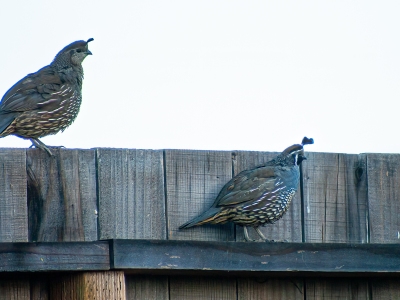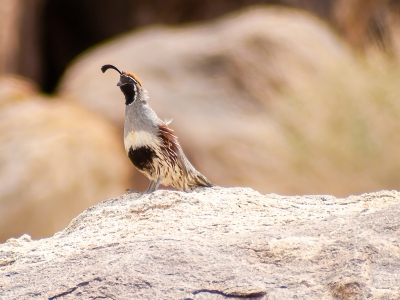Galliformes is an order of heavy-bodied ground-feeding birds that includes turkeys, chickens, quail, and other landfowl. Gallinaceous birds, as they are called, are important in their ecosystems as seed dispersers and predators, and are often reared by humans for their meat and eggs, or hunted as game birds.
The order contains about 290 species, inhabiting every continent except Antarctica, and divided into five families: Phasianidae (including chicken, quail, partridges, pheasants, turkeys, peafowl (peacocks) and grouse), Odontophoridae (New World quail), Numididae (guinea fowl), Cracidae (including chachalacas and curassows), and Megapodiidae (incubator birds like malleefowl and brush-turkeys). They adapt to most environments except for innermost deserts and perpetual ice.
 California Quail
California Quail The California quail (Callipepla californica), also known as the California valley quail or Valley quail, is a small ground-dwelling bird in the New World quail family. These birds have a curving crest or plume, made of six feathers, that droops forward: black in males and brown in females; the flanks are brown with white streaks. Males have a dark brown cap and a black face with a brown back, a grey-blue chest and a light brown belly. Females and immature birds are mainly grey-brown with a light-colored belly.
Their closest relative is Gambel's quail, which has a more southerly distribution and a longer crest at 2.5 in (6.4 cm), a brighter head and lacks the scaly appearance of the California quail. The two species separated about 1–2 million years ago, during the Late Pliocene or Early Pleistocene. It was selected as the state bird of California in 1931.
 Gambel's Quail
Gambel's Quail Gambel's quail (Callipepla gambelii) is a small ground-dwelling bird in the New World quail family. It inhabits the desert regions of Arizona, California, Colorado, New Mexico, Nevada, Utah, Texas, and Sonora; also New Mexico-border Chihuahua and the Colorado River region of Baja California. Gambel's quail is named in honor of William Gambel, a 19th-century naturalist and explorer of the Southwestern United States.
The species is not as widely introduced as the related California quail. It was, however, released on San Clemente Island in 1912 by Charles T. Howland et al., where it is currently still established.